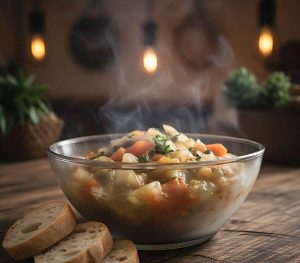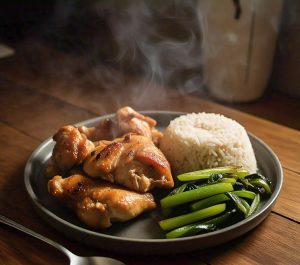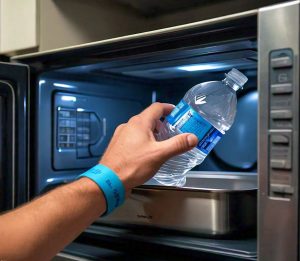Reheating food twice refers to the practice of taking leftovers, heating them up in the microwave, allowing them to cool down again, and then reheating them a second time.
The question at hand is whether or not this process can be done safely using a microwave.
This article will delve into the details of microwaving food twice. We will explore if it’s safe to do so, how long you should heat your leftovers for optimal results and whether or not this reheating process impacts the nutritional value and flavor profile of your meal. As an alternative approach to microwaving, we’ll provide tips and precautions for safe reheating as well as answer some frequently asked questions on the topic. Finally, our closing thoughts will offer advice on best practices when choosing to microwave food multiple times.

Jump To:
Is it Safe to Microwave Food Twice?
Yes, you can safely microwave food twice. However, there are some important considerations for reheating food more than once. Every time you reheat leftovers, they lose nutritional quality and flavor. Moreover, uneven heating could result in dangerous “hot spots” that harbor harmful bacteria. Ideally, only heat up the amount of food you intend to eat immediately and avoid multiple reheats.
Facts About Microwaving Food Twice
Here we will discuss the important things to note about microwaving food twice.
- Safety: Reheating food more than once may increase the risk of food poisoning caused by bacteria multiplying and producing toxins.
- Nutrient Loss: Microwaving already cooked food multiple times can lead to a further decrease in nutrient content, especially water-soluble vitamins like B and C.
- Food Quality: The taste, texture, and overall quality of the food might degrade due to repeated heating.
- Temperature Distribution: Microwave ovens often heat unevenly which increases the chances that some sections of your food might not get hot enough to kill harmful bacteria when reheated multiple times. Therefore stirring is recommended between cycles.
In conclusion, it’s generally safe to microwave your food more than once as long as you’re ensuring it reaches an internal temperature of at least 165°F (74°C) every time.
Check out if you can reheat steak in the microwave.
Now, let’s move on to other aspects related to microwaving.
How Long Can You Microwave Food Twice?
The duration for microwaving food twice varies based on the type of food and its initial temperature. It’s generally recommended to heat leftovers until they are steaming hot, which usually takes about 1-3 minutes. However, if the dish is dense or large, it might require more time—up to 5-7 minutes. Ensure that the reheated food has reached a safe internal temperature of at least 165°F.
Does Heating Food in a Microwave Destroy its Nutrients?
Microwaving does not necessarily destroy more nutrients than other cooking methods. In fact, because microwaves often cook foods quicker and use less water compared to traditional cooking methods, they may preserve nutrients better than boiling or frying would. The nutrient loss in any cooking method is primarily driven by heat exposure and leaching into water—not specifically by microwaving.
Check out if you can reheat mashed potatoes in the microwave.
Does Heating Food in a Microwave Affect its Flavors?
The impact of microwaving on flavor largely depends on the nature of the dish being reheated. Generally speaking, well-moistened dishes like stews or casseroles are likely to retain their flavor when reheated via microwave as opposed to dry foods such as meat cuts which might turn tough resulting in an alteration in taste profile.
In conclusion, we’ve addressed some common concerns around double-microwaving your meals; covering aspects from safety guidelines for how long one should reheat their meal using this method while also exploring whether nutritional value and flavor profiles stay unaffected during this process.
Up next, we will be discussing FAQs pertaining to these topics.

Frequently Asked Questions (FAQs)
We will now look at the most commonly asked questions related to microwaving food, particularly reheating food multiple times.
Can you microwave food twice?
Yes, you can microwave food twice. However, it’s crucial to ensure that your meal is heated thoroughly after the second round in the microwave for safety reasons. Food should reach a minimum internal temperature of 165°F according to FDA guidelines. But remember not to overheat as it may impact its nutritional value and taste.
Is it safe to reheat leftovers multiple times in the microwave?
Yes, it’s safe to reheat leftovers multiple times in the microwave provided that each time you’re making sure that they’re heated all the way through. Be mindful that continuous reheating can potentially reduce the quality and palatability of your food due to repeated temperature changes.
If initial heating was done by a conventional cooking method, can I use a microwave for second heating?
Certainly! If initial heating was done by conventional cooking methods like stove-top or oven, you can indeed use a microwave for secondary heating. Just be sure every part of your dish reaches at least 165°F for optimal safety.
Does microwaving affect the quality of food after multiple heatings?
Microwaving doesn’t inherently affect food quality but frequent heating might lead to loss of texture and flavor over time primarily because moisture evaporates with each successive heating session rendering food drier than before.
Check out if you can reheat shrimp in the microwave.
We hope these responses have effectively addressed some common inquiries about microwaving foods more than once!
Final Word
To conclude, while it is generally acceptable and safe from a health viewpoint to microwave food multiple times, it is vital to ensure that every portion of the meal is heated thoroughly. However, be aware that recurring microwaving might alter the texture and taste of your meals due to moisture loss. Thus, for optimal enjoyment and nutritional retention, try not to make reheating a habit!



